Contemporary Society: Intersectionality, AFL, and Swimming Analysis
VerifiedAdded on 2020/05/28
|9
|2086
|105
Essay
AI Summary
This essay delves into the theory of intersectionality and its application within contemporary society, specifically focusing on the experiences of professional athletes in the Australian Football League (AFL) and swimming. It explores how factors such as race, gender, class, and disability intersect to create unique forms of discrimination and inequality. The essay examines the concept of intersectionality, discussing its themes like structural, political, and representational aspects. It then analyzes specific instances of discrimination, including racial abuse in AFL and weight/disability-based discrimination in swimming. The essay also addresses the underrepresentation of women in sports leadership and the mental health impacts of racial discrimination. A contrast matrix is used to highlight the similarities and differences between the various themes. The conclusion emphasizes the multifaceted nature of intersectionality and its impact on social justice within the sporting world. The essay draws from various research papers and studies to support its arguments.

Running head: CONTEMPORARY SOCIETY
Contemporary Society
Name of the student
Name of the University
Author Note
Contemporary Society
Name of the student
Name of the University
Author Note
Paraphrase This Document
Need a fresh take? Get an instant paraphrase of this document with our AI Paraphraser
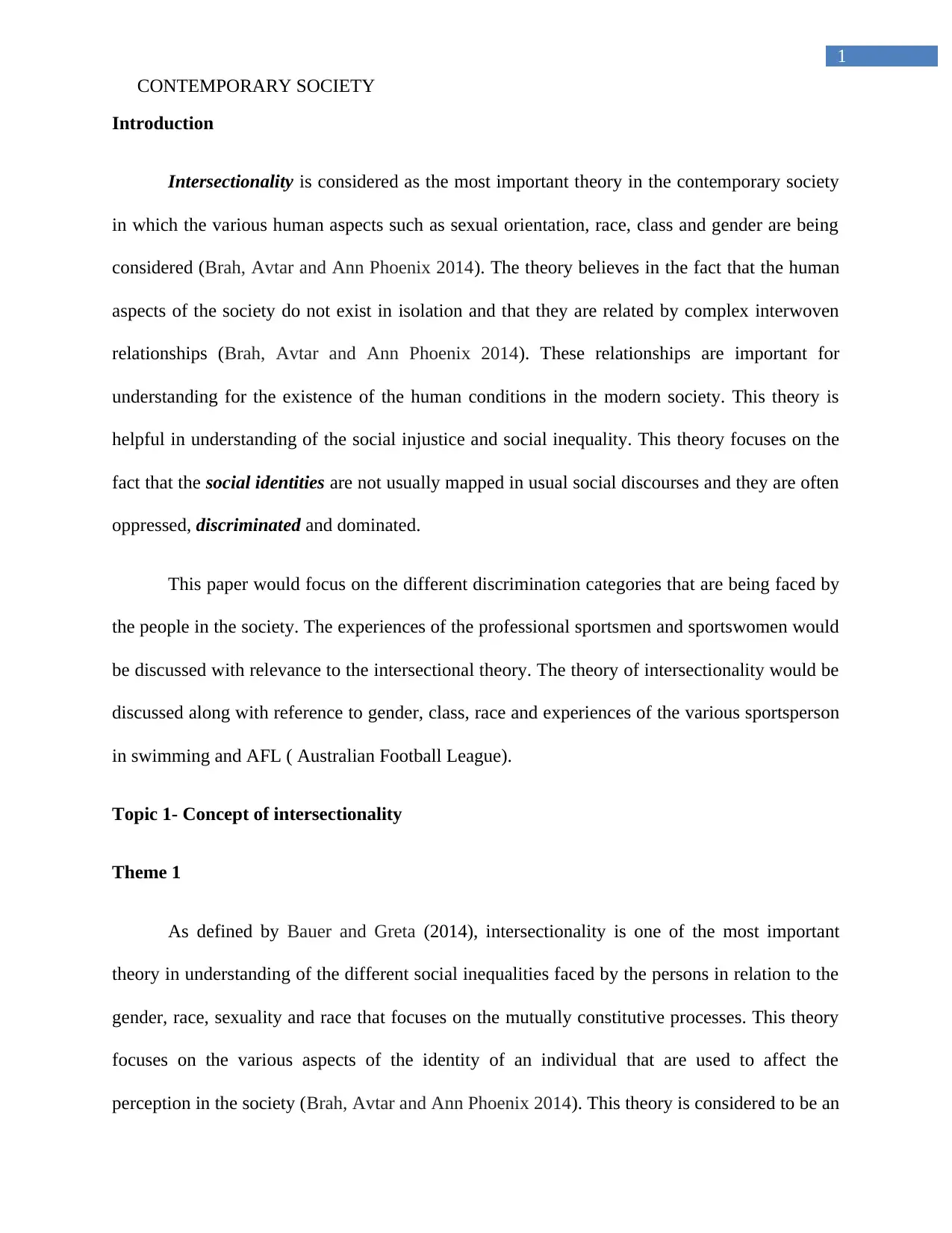
1
CONTEMPORARY SOCIETY
Introduction
Intersectionality is considered as the most important theory in the contemporary society
in which the various human aspects such as sexual orientation, race, class and gender are being
considered (Brah, Avtar and Ann Phoenix 2014). The theory believes in the fact that the human
aspects of the society do not exist in isolation and that they are related by complex interwoven
relationships (Brah, Avtar and Ann Phoenix 2014). These relationships are important for
understanding for the existence of the human conditions in the modern society. This theory is
helpful in understanding of the social injustice and social inequality. This theory focuses on the
fact that the social identities are not usually mapped in usual social discourses and they are often
oppressed, discriminated and dominated.
This paper would focus on the different discrimination categories that are being faced by
the people in the society. The experiences of the professional sportsmen and sportswomen would
be discussed with relevance to the intersectional theory. The theory of intersectionality would be
discussed along with reference to gender, class, race and experiences of the various sportsperson
in swimming and AFL ( Australian Football League).
Topic 1- Concept of intersectionality
Theme 1
As defined by Bauer and Greta (2014), intersectionality is one of the most important
theory in understanding of the different social inequalities faced by the persons in relation to the
gender, race, sexuality and race that focuses on the mutually constitutive processes. This theory
focuses on the various aspects of the identity of an individual that are used to affect the
perception in the society (Brah, Avtar and Ann Phoenix 2014). This theory is considered to be an
CONTEMPORARY SOCIETY
Introduction
Intersectionality is considered as the most important theory in the contemporary society
in which the various human aspects such as sexual orientation, race, class and gender are being
considered (Brah, Avtar and Ann Phoenix 2014). The theory believes in the fact that the human
aspects of the society do not exist in isolation and that they are related by complex interwoven
relationships (Brah, Avtar and Ann Phoenix 2014). These relationships are important for
understanding for the existence of the human conditions in the modern society. This theory is
helpful in understanding of the social injustice and social inequality. This theory focuses on the
fact that the social identities are not usually mapped in usual social discourses and they are often
oppressed, discriminated and dominated.
This paper would focus on the different discrimination categories that are being faced by
the people in the society. The experiences of the professional sportsmen and sportswomen would
be discussed with relevance to the intersectional theory. The theory of intersectionality would be
discussed along with reference to gender, class, race and experiences of the various sportsperson
in swimming and AFL ( Australian Football League).
Topic 1- Concept of intersectionality
Theme 1
As defined by Bauer and Greta (2014), intersectionality is one of the most important
theory in understanding of the different social inequalities faced by the persons in relation to the
gender, race, sexuality and race that focuses on the mutually constitutive processes. This theory
focuses on the various aspects of the identity of an individual that are used to affect the
perception in the society (Brah, Avtar and Ann Phoenix 2014). This theory is considered to be an
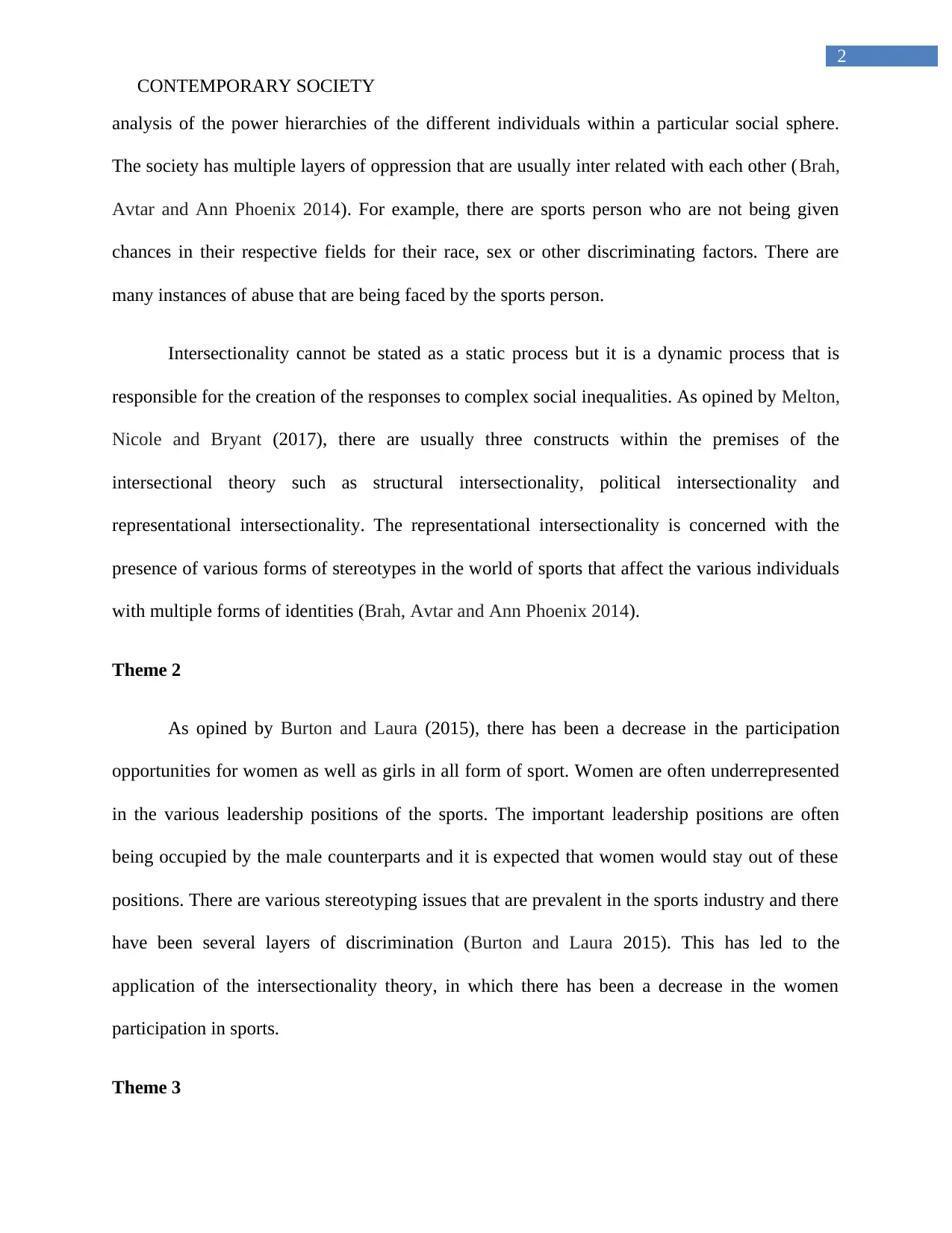
2
CONTEMPORARY SOCIETY
analysis of the power hierarchies of the different individuals within a particular social sphere.
The society has multiple layers of oppression that are usually inter related with each other (Brah,
Avtar and Ann Phoenix 2014). For example, there are sports person who are not being given
chances in their respective fields for their race, sex or other discriminating factors. There are
many instances of abuse that are being faced by the sports person.
Intersectionality cannot be stated as a static process but it is a dynamic process that is
responsible for the creation of the responses to complex social inequalities. As opined by Melton,
Nicole and Bryant (2017), there are usually three constructs within the premises of the
intersectional theory such as structural intersectionality, political intersectionality and
representational intersectionality. The representational intersectionality is concerned with the
presence of various forms of stereotypes in the world of sports that affect the various individuals
with multiple forms of identities (Brah, Avtar and Ann Phoenix 2014).
Theme 2
As opined by Burton and Laura (2015), there has been a decrease in the participation
opportunities for women as well as girls in all form of sport. Women are often underrepresented
in the various leadership positions of the sports. The important leadership positions are often
being occupied by the male counterparts and it is expected that women would stay out of these
positions. There are various stereotyping issues that are prevalent in the sports industry and there
have been several layers of discrimination (Burton and Laura 2015). This has led to the
application of the intersectionality theory, in which there has been a decrease in the women
participation in sports.
Theme 3
CONTEMPORARY SOCIETY
analysis of the power hierarchies of the different individuals within a particular social sphere.
The society has multiple layers of oppression that are usually inter related with each other (Brah,
Avtar and Ann Phoenix 2014). For example, there are sports person who are not being given
chances in their respective fields for their race, sex or other discriminating factors. There are
many instances of abuse that are being faced by the sports person.
Intersectionality cannot be stated as a static process but it is a dynamic process that is
responsible for the creation of the responses to complex social inequalities. As opined by Melton,
Nicole and Bryant (2017), there are usually three constructs within the premises of the
intersectional theory such as structural intersectionality, political intersectionality and
representational intersectionality. The representational intersectionality is concerned with the
presence of various forms of stereotypes in the world of sports that affect the various individuals
with multiple forms of identities (Brah, Avtar and Ann Phoenix 2014).
Theme 2
As opined by Burton and Laura (2015), there has been a decrease in the participation
opportunities for women as well as girls in all form of sport. Women are often underrepresented
in the various leadership positions of the sports. The important leadership positions are often
being occupied by the male counterparts and it is expected that women would stay out of these
positions. There are various stereotyping issues that are prevalent in the sports industry and there
have been several layers of discrimination (Burton and Laura 2015). This has led to the
application of the intersectionality theory, in which there has been a decrease in the women
participation in sports.
Theme 3
⊘ This is a preview!⊘
Do you want full access?
Subscribe today to unlock all pages.

Trusted by 1+ million students worldwide
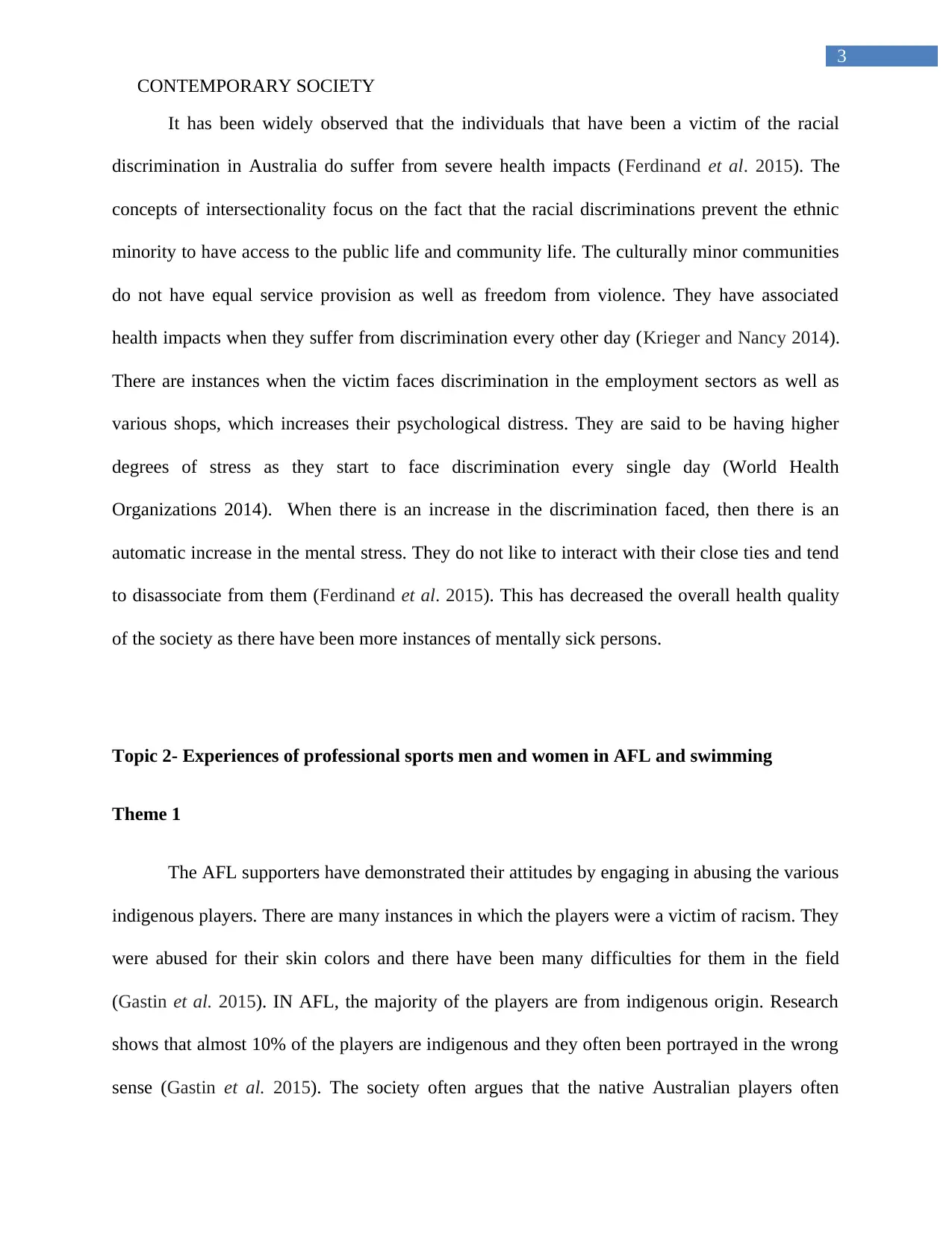
3
CONTEMPORARY SOCIETY
It has been widely observed that the individuals that have been a victim of the racial
discrimination in Australia do suffer from severe health impacts (Ferdinand et al. 2015). The
concepts of intersectionality focus on the fact that the racial discriminations prevent the ethnic
minority to have access to the public life and community life. The culturally minor communities
do not have equal service provision as well as freedom from violence. They have associated
health impacts when they suffer from discrimination every other day (Krieger and Nancy 2014).
There are instances when the victim faces discrimination in the employment sectors as well as
various shops, which increases their psychological distress. They are said to be having higher
degrees of stress as they start to face discrimination every single day (World Health
Organizations 2014). When there is an increase in the discrimination faced, then there is an
automatic increase in the mental stress. They do not like to interact with their close ties and tend
to disassociate from them (Ferdinand et al. 2015). This has decreased the overall health quality
of the society as there have been more instances of mentally sick persons.
Topic 2- Experiences of professional sports men and women in AFL and swimming
Theme 1
The AFL supporters have demonstrated their attitudes by engaging in abusing the various
indigenous players. There are many instances in which the players were a victim of racism. They
were abused for their skin colors and there have been many difficulties for them in the field
(Gastin et al. 2015). IN AFL, the majority of the players are from indigenous origin. Research
shows that almost 10% of the players are indigenous and they often been portrayed in the wrong
sense (Gastin et al. 2015). The society often argues that the native Australian players often
CONTEMPORARY SOCIETY
It has been widely observed that the individuals that have been a victim of the racial
discrimination in Australia do suffer from severe health impacts (Ferdinand et al. 2015). The
concepts of intersectionality focus on the fact that the racial discriminations prevent the ethnic
minority to have access to the public life and community life. The culturally minor communities
do not have equal service provision as well as freedom from violence. They have associated
health impacts when they suffer from discrimination every other day (Krieger and Nancy 2014).
There are instances when the victim faces discrimination in the employment sectors as well as
various shops, which increases their psychological distress. They are said to be having higher
degrees of stress as they start to face discrimination every single day (World Health
Organizations 2014). When there is an increase in the discrimination faced, then there is an
automatic increase in the mental stress. They do not like to interact with their close ties and tend
to disassociate from them (Ferdinand et al. 2015). This has decreased the overall health quality
of the society as there have been more instances of mentally sick persons.
Topic 2- Experiences of professional sports men and women in AFL and swimming
Theme 1
The AFL supporters have demonstrated their attitudes by engaging in abusing the various
indigenous players. There are many instances in which the players were a victim of racism. They
were abused for their skin colors and there have been many difficulties for them in the field
(Gastin et al. 2015). IN AFL, the majority of the players are from indigenous origin. Research
shows that almost 10% of the players are indigenous and they often been portrayed in the wrong
sense (Gastin et al. 2015). The society often argues that the native Australian players often
Paraphrase This Document
Need a fresh take? Get an instant paraphrase of this document with our AI Paraphraser
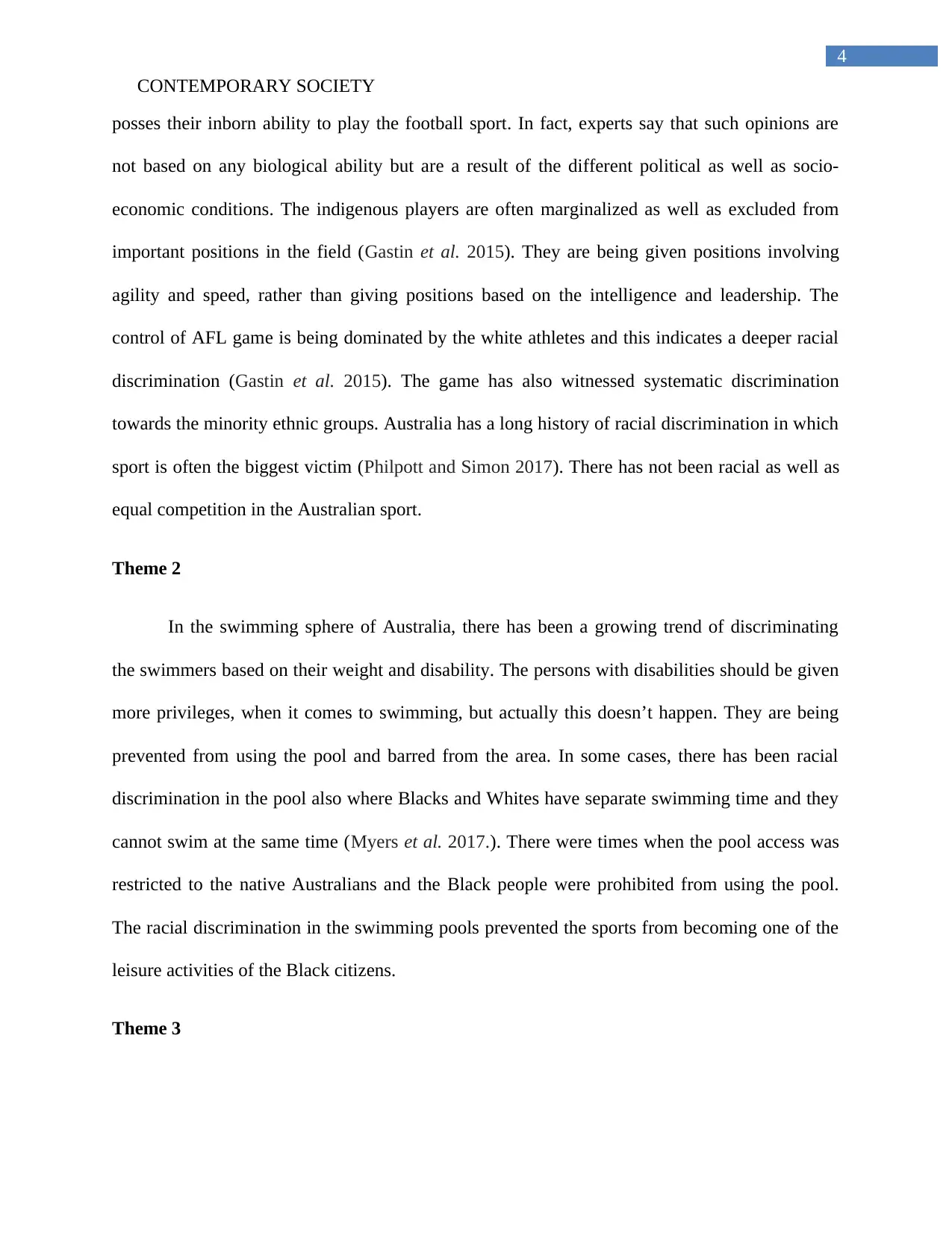
4
CONTEMPORARY SOCIETY
posses their inborn ability to play the football sport. In fact, experts say that such opinions are
not based on any biological ability but are a result of the different political as well as socio-
economic conditions. The indigenous players are often marginalized as well as excluded from
important positions in the field (Gastin et al. 2015). They are being given positions involving
agility and speed, rather than giving positions based on the intelligence and leadership. The
control of AFL game is being dominated by the white athletes and this indicates a deeper racial
discrimination (Gastin et al. 2015). The game has also witnessed systematic discrimination
towards the minority ethnic groups. Australia has a long history of racial discrimination in which
sport is often the biggest victim (Philpott and Simon 2017). There has not been racial as well as
equal competition in the Australian sport.
Theme 2
In the swimming sphere of Australia, there has been a growing trend of discriminating
the swimmers based on their weight and disability. The persons with disabilities should be given
more privileges, when it comes to swimming, but actually this doesn’t happen. They are being
prevented from using the pool and barred from the area. In some cases, there has been racial
discrimination in the pool also where Blacks and Whites have separate swimming time and they
cannot swim at the same time (Myers et al. 2017.). There were times when the pool access was
restricted to the native Australians and the Black people were prohibited from using the pool.
The racial discrimination in the swimming pools prevented the sports from becoming one of the
leisure activities of the Black citizens.
Theme 3
CONTEMPORARY SOCIETY
posses their inborn ability to play the football sport. In fact, experts say that such opinions are
not based on any biological ability but are a result of the different political as well as socio-
economic conditions. The indigenous players are often marginalized as well as excluded from
important positions in the field (Gastin et al. 2015). They are being given positions involving
agility and speed, rather than giving positions based on the intelligence and leadership. The
control of AFL game is being dominated by the white athletes and this indicates a deeper racial
discrimination (Gastin et al. 2015). The game has also witnessed systematic discrimination
towards the minority ethnic groups. Australia has a long history of racial discrimination in which
sport is often the biggest victim (Philpott and Simon 2017). There has not been racial as well as
equal competition in the Australian sport.
Theme 2
In the swimming sphere of Australia, there has been a growing trend of discriminating
the swimmers based on their weight and disability. The persons with disabilities should be given
more privileges, when it comes to swimming, but actually this doesn’t happen. They are being
prevented from using the pool and barred from the area. In some cases, there has been racial
discrimination in the pool also where Blacks and Whites have separate swimming time and they
cannot swim at the same time (Myers et al. 2017.). There were times when the pool access was
restricted to the native Australians and the Black people were prohibited from using the pool.
The racial discrimination in the swimming pools prevented the sports from becoming one of the
leisure activities of the Black citizens.
Theme 3
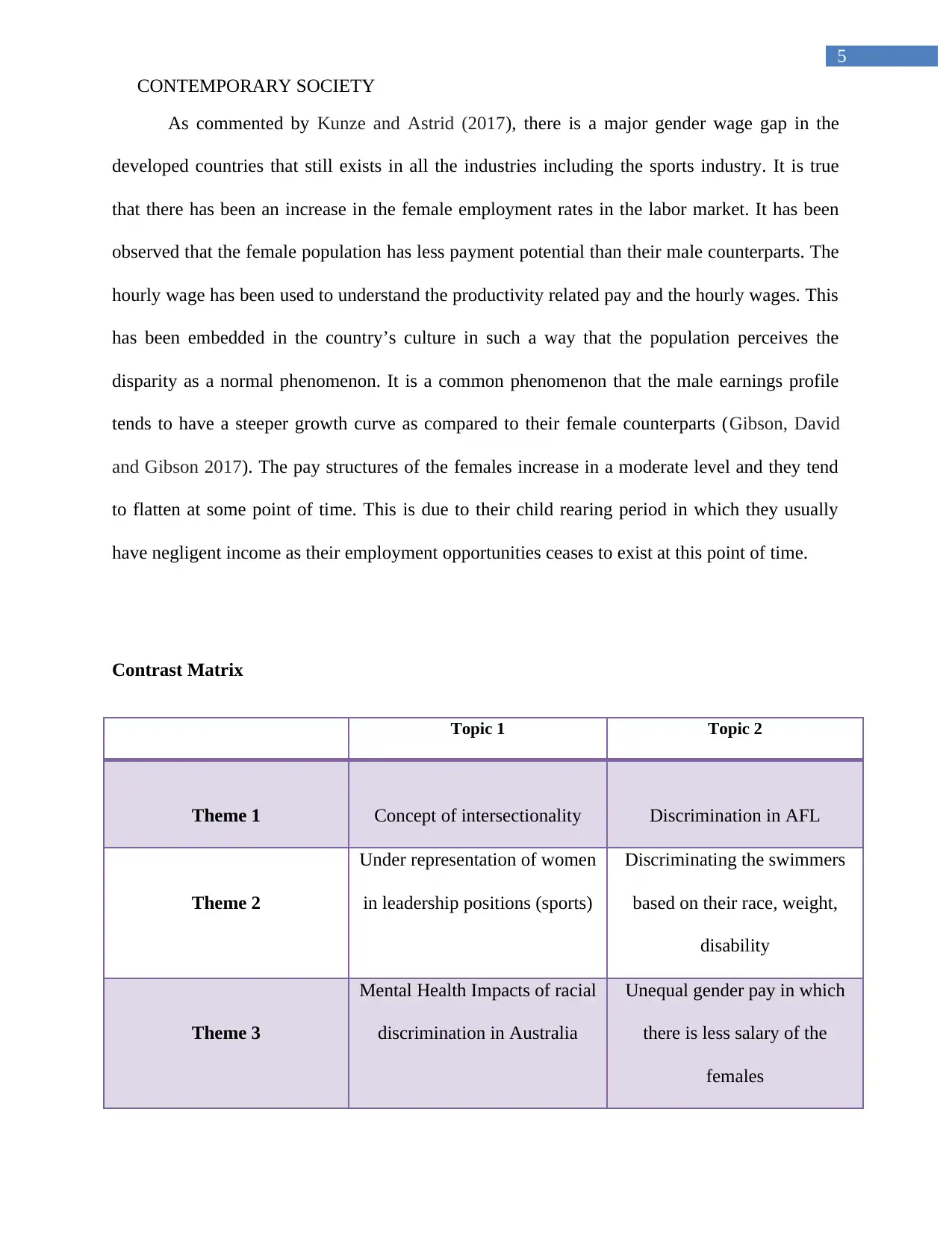
5
CONTEMPORARY SOCIETY
As commented by Kunze and Astrid (2017), there is a major gender wage gap in the
developed countries that still exists in all the industries including the sports industry. It is true
that there has been an increase in the female employment rates in the labor market. It has been
observed that the female population has less payment potential than their male counterparts. The
hourly wage has been used to understand the productivity related pay and the hourly wages. This
has been embedded in the country’s culture in such a way that the population perceives the
disparity as a normal phenomenon. It is a common phenomenon that the male earnings profile
tends to have a steeper growth curve as compared to their female counterparts (Gibson, David
and Gibson 2017). The pay structures of the females increase in a moderate level and they tend
to flatten at some point of time. This is due to their child rearing period in which they usually
have negligent income as their employment opportunities ceases to exist at this point of time.
Contrast Matrix
Topic 1 Topic 2
Theme 1 Concept of intersectionality Discrimination in AFL
Theme 2
Under representation of women
in leadership positions (sports)
Discriminating the swimmers
based on their race, weight,
disability
Theme 3
Mental Health Impacts of racial
discrimination in Australia
Unequal gender pay in which
there is less salary of the
females
CONTEMPORARY SOCIETY
As commented by Kunze and Astrid (2017), there is a major gender wage gap in the
developed countries that still exists in all the industries including the sports industry. It is true
that there has been an increase in the female employment rates in the labor market. It has been
observed that the female population has less payment potential than their male counterparts. The
hourly wage has been used to understand the productivity related pay and the hourly wages. This
has been embedded in the country’s culture in such a way that the population perceives the
disparity as a normal phenomenon. It is a common phenomenon that the male earnings profile
tends to have a steeper growth curve as compared to their female counterparts (Gibson, David
and Gibson 2017). The pay structures of the females increase in a moderate level and they tend
to flatten at some point of time. This is due to their child rearing period in which they usually
have negligent income as their employment opportunities ceases to exist at this point of time.
Contrast Matrix
Topic 1 Topic 2
Theme 1 Concept of intersectionality Discrimination in AFL
Theme 2
Under representation of women
in leadership positions (sports)
Discriminating the swimmers
based on their race, weight,
disability
Theme 3
Mental Health Impacts of racial
discrimination in Australia
Unequal gender pay in which
there is less salary of the
females
⊘ This is a preview!⊘
Do you want full access?
Subscribe today to unlock all pages.

Trusted by 1+ million students worldwide

6
CONTEMPORARY SOCIETY
Fig: Contrast Matrix
Source: Created by author
Conclusion
The above topics and the various themes have led to a fact that there are certain
similarities as well as dissimilarities in the overall intersectionality process. The concept of
intersectionality was discussed in the first theme, which is similar to the first theme of the second
topic in which the discrimination in the AFL is considered. However, the other themes are
diverse from each other. In one theme, the under representation of women in leadership positions
especially in the sports industry is being determined. In the next theme, the different mental
health impacts of racial discrimination in Australia were discussed. One of the most important
themes discussed was the discrimination of the swimmers based on their race, weight and
disability. The increasing gender inequality have also been discussed in the last theme.
CONTEMPORARY SOCIETY
Fig: Contrast Matrix
Source: Created by author
Conclusion
The above topics and the various themes have led to a fact that there are certain
similarities as well as dissimilarities in the overall intersectionality process. The concept of
intersectionality was discussed in the first theme, which is similar to the first theme of the second
topic in which the discrimination in the AFL is considered. However, the other themes are
diverse from each other. In one theme, the under representation of women in leadership positions
especially in the sports industry is being determined. In the next theme, the different mental
health impacts of racial discrimination in Australia were discussed. One of the most important
themes discussed was the discrimination of the swimmers based on their race, weight and
disability. The increasing gender inequality have also been discussed in the last theme.
Paraphrase This Document
Need a fresh take? Get an instant paraphrase of this document with our AI Paraphraser
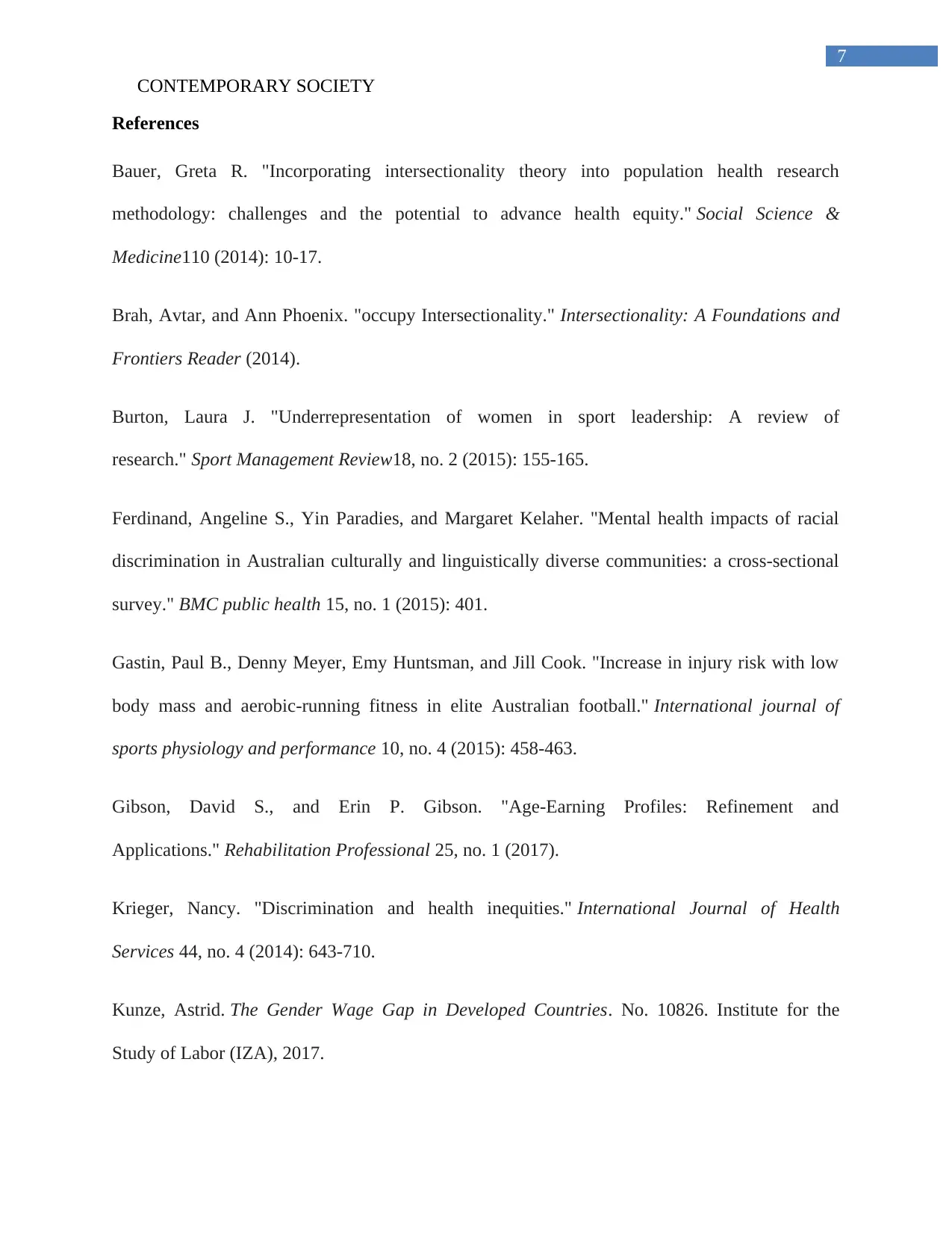
7
CONTEMPORARY SOCIETY
References
Bauer, Greta R. "Incorporating intersectionality theory into population health research
methodology: challenges and the potential to advance health equity." Social Science &
Medicine110 (2014): 10-17.
Brah, Avtar, and Ann Phoenix. "occupy Intersectionality." Intersectionality: A Foundations and
Frontiers Reader (2014).
Burton, Laura J. "Underrepresentation of women in sport leadership: A review of
research." Sport Management Review18, no. 2 (2015): 155-165.
Ferdinand, Angeline S., Yin Paradies, and Margaret Kelaher. "Mental health impacts of racial
discrimination in Australian culturally and linguistically diverse communities: a cross-sectional
survey." BMC public health 15, no. 1 (2015): 401.
Gastin, Paul B., Denny Meyer, Emy Huntsman, and Jill Cook. "Increase in injury risk with low
body mass and aerobic-running fitness in elite Australian football." International journal of
sports physiology and performance 10, no. 4 (2015): 458-463.
Gibson, David S., and Erin P. Gibson. "Age-Earning Profiles: Refinement and
Applications." Rehabilitation Professional 25, no. 1 (2017).
Krieger, Nancy. "Discrimination and health inequities." International Journal of Health
Services 44, no. 4 (2014): 643-710.
Kunze, Astrid. The Gender Wage Gap in Developed Countries. No. 10826. Institute for the
Study of Labor (IZA), 2017.
CONTEMPORARY SOCIETY
References
Bauer, Greta R. "Incorporating intersectionality theory into population health research
methodology: challenges and the potential to advance health equity." Social Science &
Medicine110 (2014): 10-17.
Brah, Avtar, and Ann Phoenix. "occupy Intersectionality." Intersectionality: A Foundations and
Frontiers Reader (2014).
Burton, Laura J. "Underrepresentation of women in sport leadership: A review of
research." Sport Management Review18, no. 2 (2015): 155-165.
Ferdinand, Angeline S., Yin Paradies, and Margaret Kelaher. "Mental health impacts of racial
discrimination in Australian culturally and linguistically diverse communities: a cross-sectional
survey." BMC public health 15, no. 1 (2015): 401.
Gastin, Paul B., Denny Meyer, Emy Huntsman, and Jill Cook. "Increase in injury risk with low
body mass and aerobic-running fitness in elite Australian football." International journal of
sports physiology and performance 10, no. 4 (2015): 458-463.
Gibson, David S., and Erin P. Gibson. "Age-Earning Profiles: Refinement and
Applications." Rehabilitation Professional 25, no. 1 (2017).
Krieger, Nancy. "Discrimination and health inequities." International Journal of Health
Services 44, no. 4 (2014): 643-710.
Kunze, Astrid. The Gender Wage Gap in Developed Countries. No. 10826. Institute for the
Study of Labor (IZA), 2017.

8
CONTEMPORARY SOCIETY
Melton, E. Nicole, and Michael J. Bryant. "Intersectionality: the impact of negotiating multiple
identities for women in sport leadership." Women in Sport Leadership: Research and Practice
for Change (2017): 62.
Myers, Samuel L., Ana Cuesta, and Yufeng Lai. "Competitive Swimming and Racial Disparities
in Drowning." The Review of Black Political Economy (2017): 1-21.
Philpott, Simon. "Planet of the Australians: Indigenous athletes and Australian Football’s sports
diplomacy." Third World Quarterly 38, no. 4 (2017): 862-881.
World Health Organization. Social determinants of mental health. World Health Organization,
2014.
CONTEMPORARY SOCIETY
Melton, E. Nicole, and Michael J. Bryant. "Intersectionality: the impact of negotiating multiple
identities for women in sport leadership." Women in Sport Leadership: Research and Practice
for Change (2017): 62.
Myers, Samuel L., Ana Cuesta, and Yufeng Lai. "Competitive Swimming and Racial Disparities
in Drowning." The Review of Black Political Economy (2017): 1-21.
Philpott, Simon. "Planet of the Australians: Indigenous athletes and Australian Football’s sports
diplomacy." Third World Quarterly 38, no. 4 (2017): 862-881.
World Health Organization. Social determinants of mental health. World Health Organization,
2014.
⊘ This is a preview!⊘
Do you want full access?
Subscribe today to unlock all pages.

Trusted by 1+ million students worldwide
1 out of 9
Related Documents
Your All-in-One AI-Powered Toolkit for Academic Success.
+13062052269
info@desklib.com
Available 24*7 on WhatsApp / Email
![[object Object]](/_next/static/media/star-bottom.7253800d.svg)
Unlock your academic potential
Copyright © 2020–2025 A2Z Services. All Rights Reserved. Developed and managed by ZUCOL.





